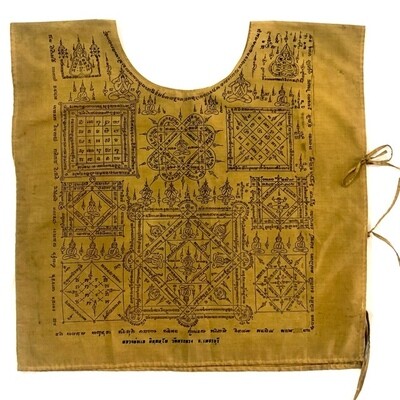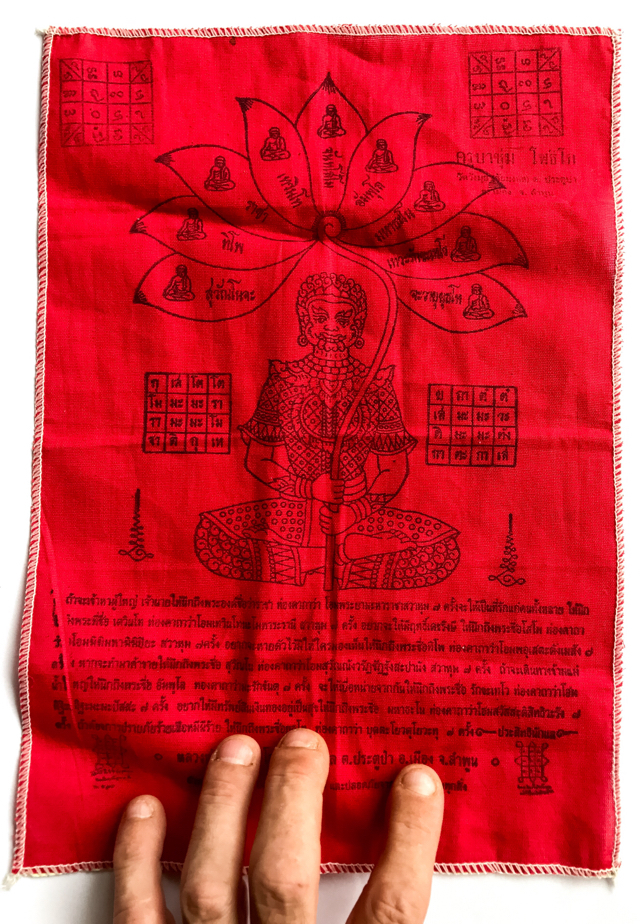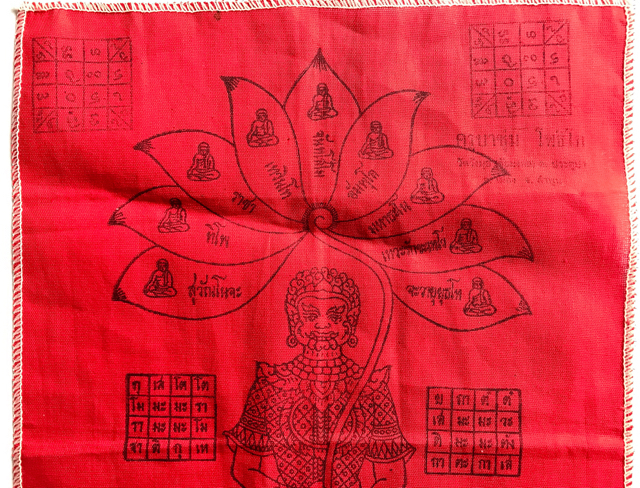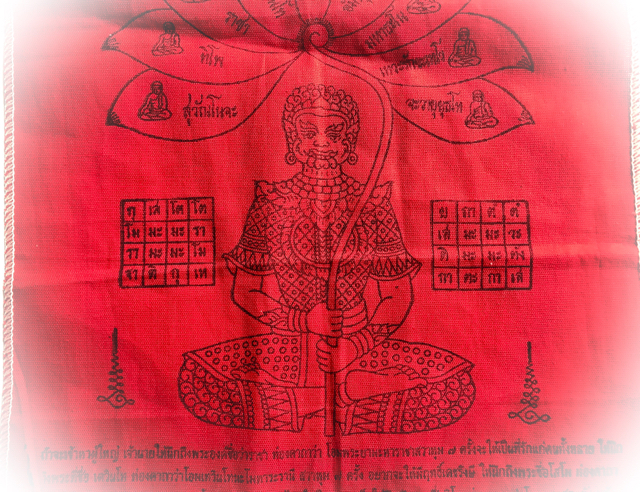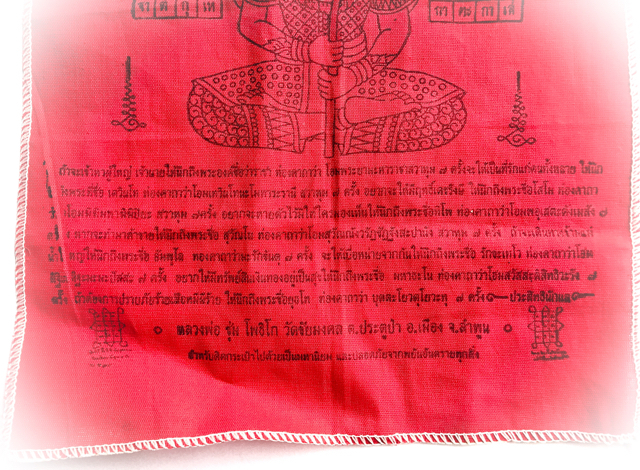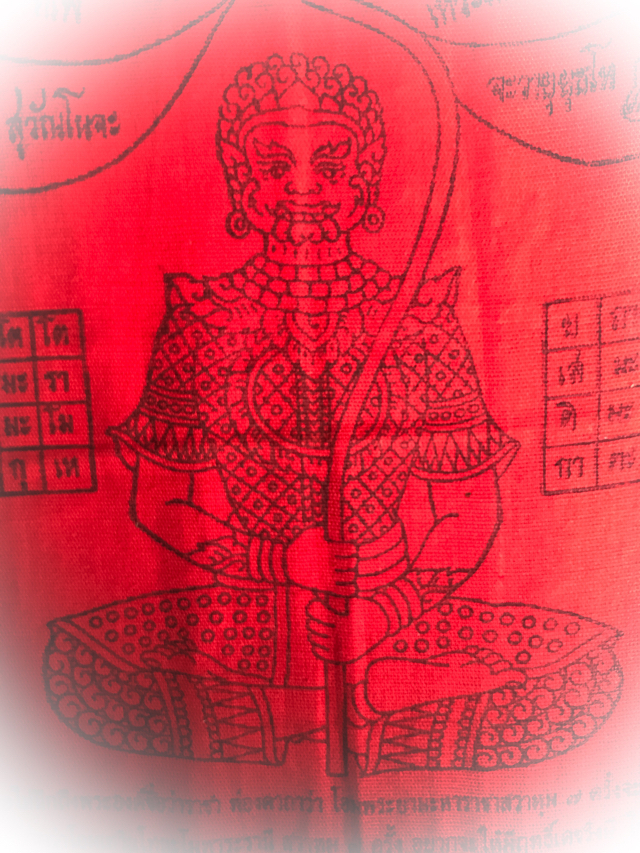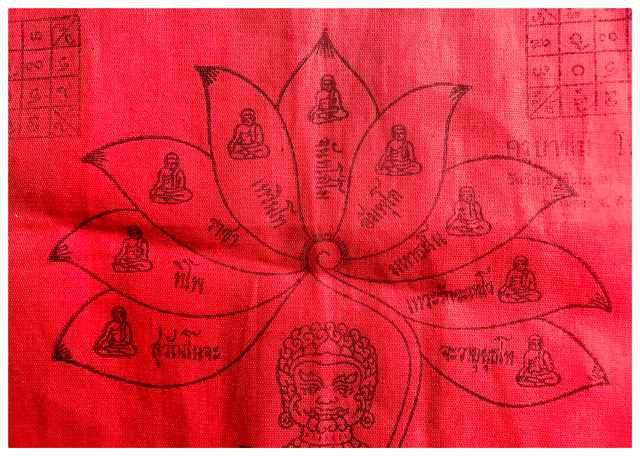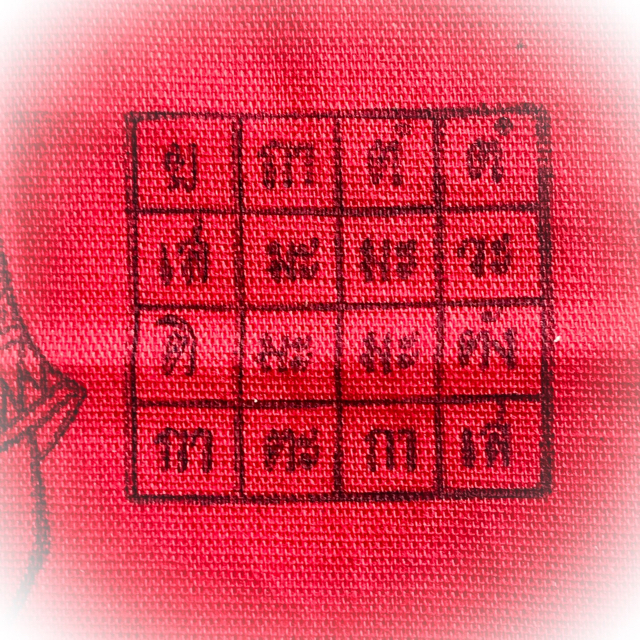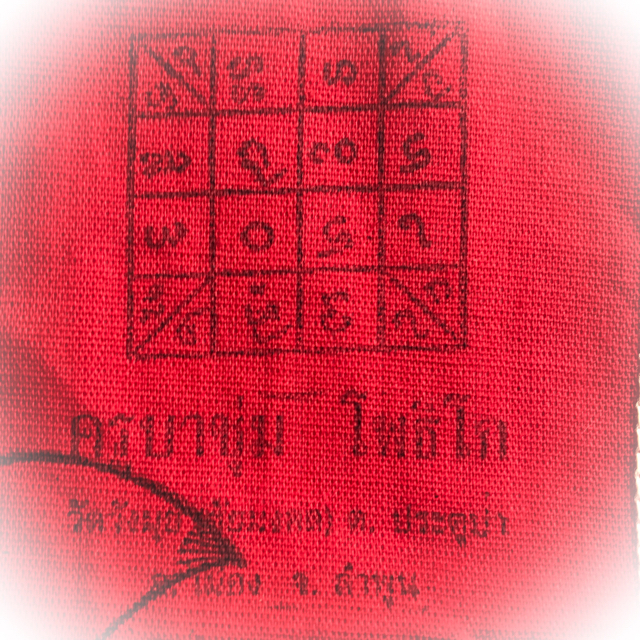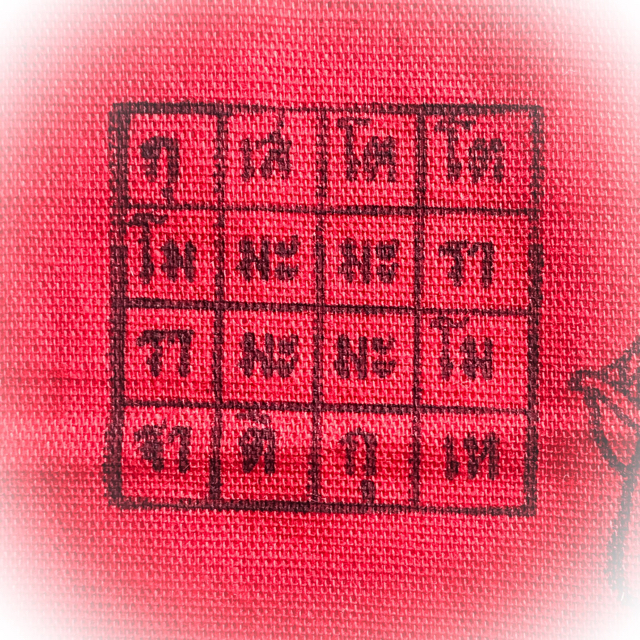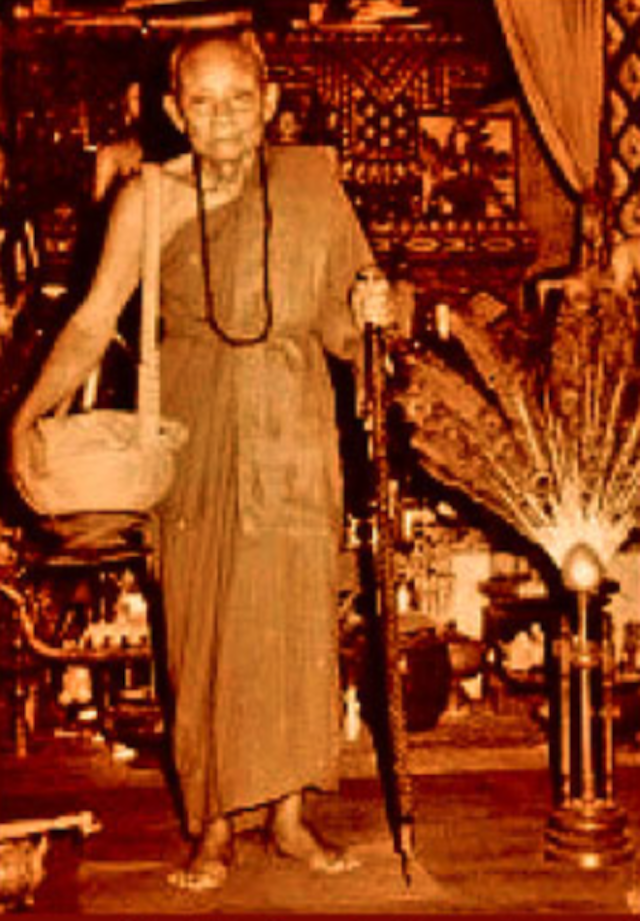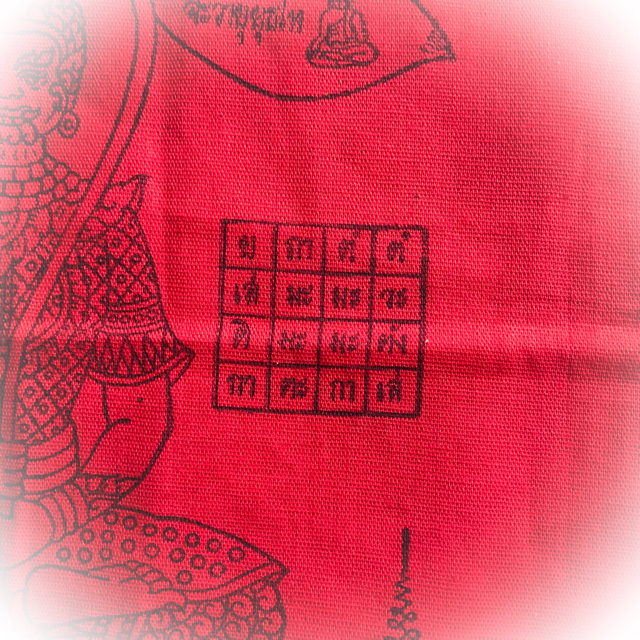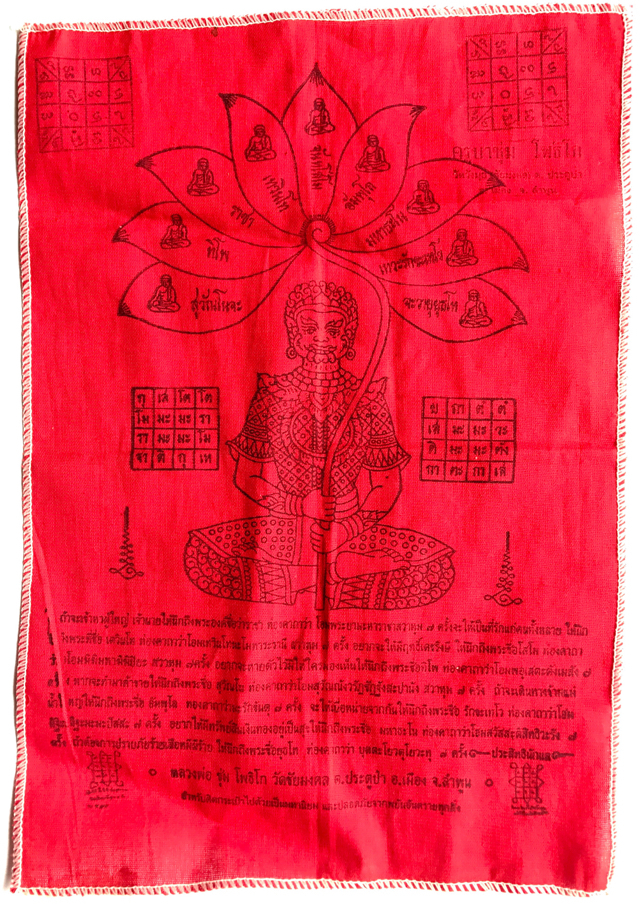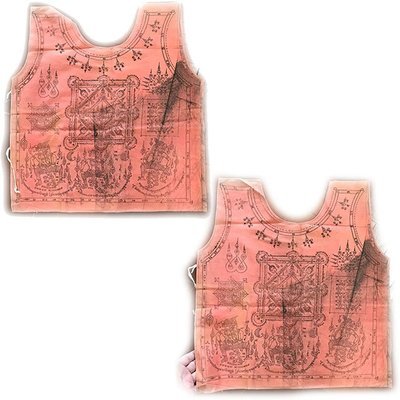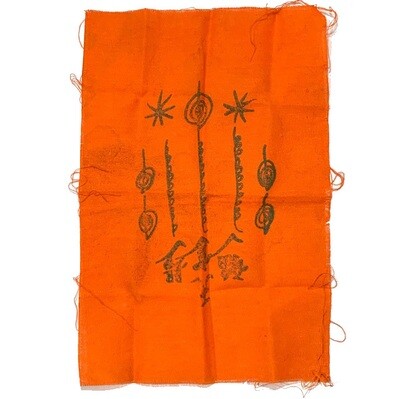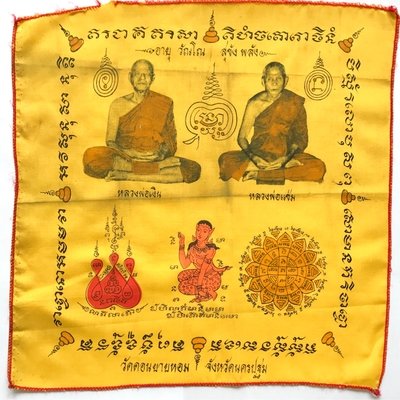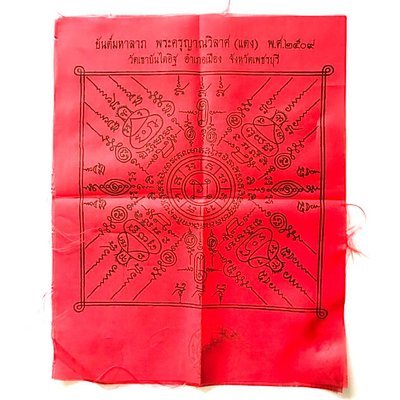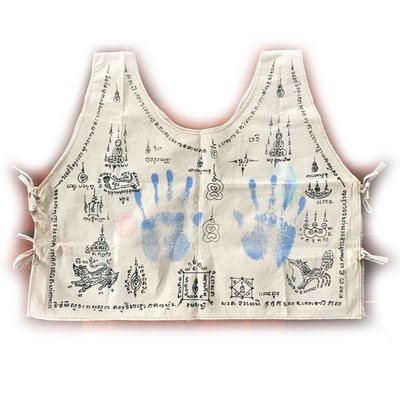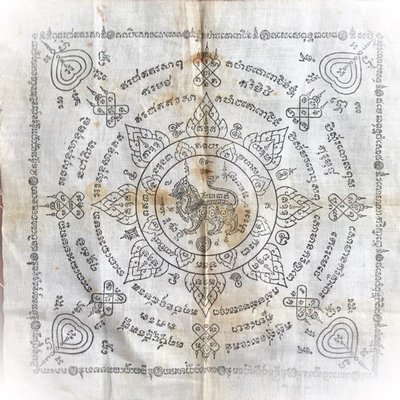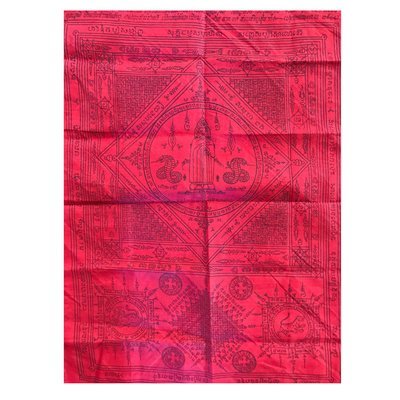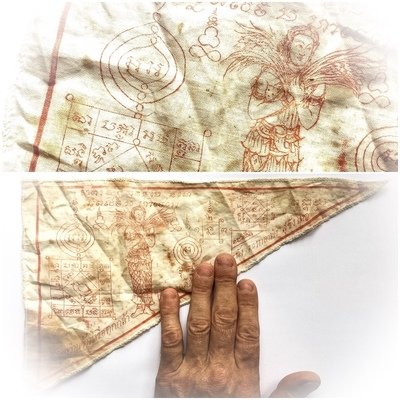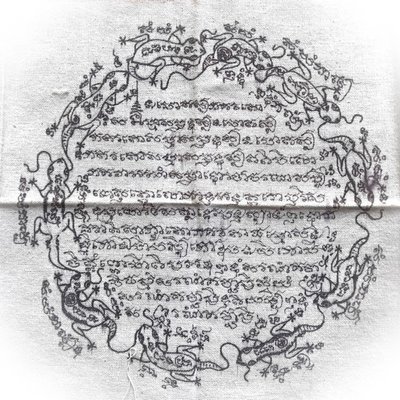Presenting a tiny but powerful and rare classic amulet from one of the Great Khao Or Masters of the 20th Century, Rian Glom Lek Hlang Chedi 2505 BE Nuea Tong Daeng Miniature Guru Monk Coin Por Tan Klai Wajasit
This Sacred amulet of the Great Khao Or Master of Nakorn Sri Tammarat, Master of Wat San Khan and Wat Pratat Noi, is a very rare amulet from Por Tan Klai’s 2505 BE Blessing Ceremony Edition, and is considered a ‘Jaek mae Krua’ type amulet (meaning ‘give to the kitchen maids and temple helpers’), which is suitable not only for men, but due to its miniature size, a perfect amulet for ladies or children to wear.

Rian Glom Lek 2505 BE Por Tan Klai Wajasit Wat Suan Khan
The 2505 BE edition of amulets of Por Tan Klai, is a highly preferred edition, which saw his famous ‘Rian Glom’ round Monk coin amulet with Chakra released, The Rian Glom Lek Hlang Chedi, and the Roop Tai Por Tan Klai Guru Monk Blesséd Photographamulets such as look om chan hmak and ya sen tobacco balls, and sacred powder amulets of various models.
A very rare and highly prized amulet for the devotees of Por Tan Klai to associate with his image and pray to him with a blessed image of the Guru, and the Chedi Relic Stupa on rear face for Buddhanussati and Marananussati. A powerful and Sacred amulet which has passed through the hands of the Guru and been blessed by him.
Por Tan Klai was one of the Top Guru Master Monks of the Last Century, and is considered one of the Four Great Masters of the Previous Generation of Lineage Masters of the Khao Or Southern Sorcery Lineage.
Kata Bucha Por Tan Klai
Pha Yant Pra Pirab Taewarach Gao Pra Ongk - Bhairaba + 9 Heavenly Kings Yantra - Luang Phu Kroo Ba Chum Wat Wang Mui
Pha Yant Pra Pirab Pra Taewarach Gao Pra Ongk Bhairaba Yaksa Asura Deva, with 9 Special Incantations of the Celestial Kings Yantra Cloth from Kroo Ba Chum of Wat Wang Mui
The Yantra cloth is intended for carrying in the purse, wallet, or cashtill, to attract good business and customers, and induce mercy charm and seductive influence. The Pha Yant is empowered with various Incantations, each of which can be used to onvoke specific magical spells, for different purposes. An explanation of how to invoke the different powers is given at the end of this article.
In the Thai Mythologies, Pra Pirab is a Yaksa Giant who is featured in Valmiki's Ramayana, and is a Deity of the Thai Buddhist and of Brahman People. Pra Pirab is a Lersi Hermit sage, and is a Great Astrologer and Magician. Pra Pirab is a Powerful High ranking Royal Member of the Asura Realm Pantheon of Deities, and is known to be the Guru of all Performing Artists and Musicians. Pra Pirab is a very Powerful Magical Emanation, and possesses Maha Amnaj Power to produce 'Serm Yos' (Improve Status), and Impose Commanding Influence over others. Pra Pirab also Destroys Enemies and Backstabbers, much like the Eclipse God 'Pra Rahu'. Hence, 'Bhairaba', became first 'Pairab' and later slowly transformed into 'Pra Pirab'. Historically one can see Pra Pirab appear in Thai Performing Arts and Ritual Ceremonies documented, from about the time of the Ayuttaya Dynasty. The ritual worship of Pra Pirab was first seen to be commonly widespread during the time of the 2 King of the Chakri Dynasty.
It is believed that Pra Pirab is actually an emanation of the Lord Shiva himself, but is often mixed up with another Yaksa who appears in the Thai Ramakien Myth (adapted from India's Ramayana Myth from the Hermit Valmiki), who is named 'Wirat' or 'Pirat' and his name has often been re-written as 'Pirab'. Wirat was a Major Protagonist in the Ramakien Tale, and was a practitioner of Astrology, and Wicha Yant
In the Tibetan Vajrayana, Pirab is called 'Bhairava', and represents the wandering form of Lord Shiva and they guard the cardinal points. There are 64 Bhairavas. These 64 Bhairavas are grouped under 8 categories and each category is headed by one major Bhairava. The major eight Bhairava's are called Aṣṭāṅga Bhairavas.
The Ashta Bhairavas control the 8 directions of this universe. Each Bhairava has eight sub Bhairavas under them, totaling 64 Bhairavas. All of the Bhairavas are ruled and controlled by Maha Swarna Kala Bhairava otherwise known as Kala Bhairava, who is the supreme ruler of time of this universe as per Hindu scriptures. Bhairavi is the consort of Kala Bhairava Bhairava is also called as protector, as he guards the eight directions of the universe.
In all Hindu temples, there will be a Bhairava idol. This Bhairava is the protector of the temple. In Shiva temples, when the temple is closed, the keys are placed before Bhairava. Bhairava is also described as the protector of women. He is described as the protector of the timid and in general women who are timid in nature.
The Pha Yant has Pra Pirab seated in Meditation performming Incantation which emanate above his head as the nine lotus petals with Arahants emblazoned on them. each lotus petal has a'Hua Jai' Heart Mantra, from a longer Incantation. Each petal contains a different Incantation, which invokes different types of magic. He is surrounded by supplementary magic squares Yantra to cover backs of the primary spells.
Pra Pirab is Inherently Imbued with Maha Amnaj (commanding power and influence), Gae Aathan and Serm Yos Power, and is especially powerful Deity to watch over, guide and protect those in the Performing Arts Professions, Musicians and Dancers, as well as all Magicians. He is also the Deity of the Science of Astrology, and worshiped as the Kroo Ba Ajarn of this Profession.
He is seen to be worshiped in many great Wai Kroo ceremonies, and is the official Mascot of the Wai Kroo of Performing Artists along with a number of other Major role players in the Pantheon of 'Duriya Taep' performing Arts Heavenly Devas. Pra Pirab is the Highest Kroo of the Dancing Arts and the Musical Arts. He has various different names, the Original coming from the Indian 'Bhairaba'. As the Hindu Brahman Faith entered into Siam, the people of Siam adopted their Dance, Theater and Literary Arts, and adapted them by changing the artistic interpretation, style of regalia and their Names.
The origin of Bhairava can be traced to a conversation between Brahma and Vishnu which is recounted in the Shiv Mahapuran. In it, Vishnu inquired of Brahma, "Who is the supreme creator of the Universe?" Arrogantly, Brahma told Vishnu to worship him as Supreme Creator. One day, Brahma thought "I have five heads. Shiva also has five heads. I can do everything that Shiva does and therefore I am Shiva." Brahma became a little egotistical as a result of this. Additionally, he began to forge the work of Shiva and also started interfering in what Shiva was supposed to be doing. Consequently, Mahadeva (Shiva) threw a small nail from his finger which assumed the form of Kala Bhairava and casually went to cut off one of Brahma's heads.
The skull of Brahma is held in the hands of Kala Bhairava; Brahma Kapala in the hands of Kala Bhairava and Brahma’s ego was destroyed and he became enlightened. From then on, he became useful to himself, to the world and deeply grateful to Shiva. In the form of the Kala Bhairava, Shiva is said to be guarding each of these Shaktipeeths. Each Shaktipeeth temple is accompanied by a temple dedicated to Bhaira
Luang Phu Kroo Ba Chum of Wat Wang Mui was one of the Great Guru Masters of the Thai Lanna Northern Sorcery Tradition, whose Talismanic Amulets command great respect and reverence, and are Legendary Prominent members of the Dtamra Lanna.
His amulets are considered Master-Class, and are seen to grace the showrooms of the top auction rooms and museum cases of the serious devotee-aficionado, and avid collector of the Lanna Genre of Thai Buddhist Amulets.
Luang Phu Kroo Ba Chum Potigo, of Wat Chai Mongkol (Wat Wang Mui), in Lampoon was born on the 7th February 2442 BE in the year of the Pig. He was given the name of 'Chum', with the surname of his parents Mr Moon, and Mrs. Lun 'Pla Win'. he had 6 Siblings, 3 of them sisters, and was the 5th child of the marriage. His family were an Ethnic Minority known as the La (or sometimes called 'Wa' or 'Lwa') people, and were farmers by profession. When the young boy Chum was old enough to help his parents with the farm fields, and the household chores. He was an extremely helpful child and was always doing more than is share to relieve his parents of their burdensin all areas of the daily workload.
When Kroo Ba Chum reached adolescence he went to study and be schooled at Wart Sri Sorng Mueang (Wat Hang). He learned the ways of chanting the many Mantras and Pali Prayers, and the Dhamma from the abbot of Wat Sri Sorng Mueang. Because Kroo Ba Chum was an excellent listener and learner, highly attentive, and caught on very quickly,he because the most favoured student of the abbot and other monks of the temple, and he was able to listen and learn the Dhamma of the Lord Buddha to the point of excellence, receiving the teachings every day as he attended and sought out the abbot for more teachings. This basic early foundation of training was to bring Kroo Ba Chum his great enlightened understanding of the Buddha-Dhamma very early on in his life. This in turn cause Kroo Ba Chum to see the Ordained Sangha and the path of the Buddhist Monk to be the most attractive option in life, and he developed greater interest in the Ordained Life.
At the age of 12 years old, the young Chum asked his parents for permission to ordain as a Samanera Novice monk, and he Ordained at Wat Pratat Khaw, under the great Lanna Master, Kroo Ba Inta, as his Upachaya. Luang Phu Kroo Ba Chum made a solemn oath to himself that from that moment on he would devote his whole life to the Buddha-Dhamma as an Ordained Monk, and give is life in the service of Buddhism. When he reached the age of 20, he decided to return to Lampun Province for his reordination into the mature level of a fully fledged Bhikkhu at the temple of Wat wang Mui, once more with Kroo Ba Inta, of Wat Pratat Khaw, as Upachaya Ordaining Kroo Ba Ajarn., Pra Ajarn Hmeun as his Gammawajajarn Promting Officer, and Pra Ajarn Luang Aay as his Anusawanajarn Witness. He was given the 'Chaya' (monks name) of 'Potigo'
Kroo Ba Chum thereafter studied Dhamma theory and practiced applied Meditation and Vinaya with ever increasing diligence and intensity. and the 40 Vipassana Kammathana methods as taught and decreed as the proper practice by the Lord Buddha Sakramuni. He developed is skills and purified his heart of the many Kilesas (Defilements) which shroud it. Iin addition to developing the eightfold path, he also studied aside from this the Sacred Agkhara lettering of magical inscription, and the methods of spellcasting and empowerment of amulets, including the great Dtamra Yant Maha Pichai Songkram Ritual, which was used to conquer enemies and win wars in ancient times, and is one of the most complex and difficult Wicha to Master. Luang Phu Kroo Ba Chum was able to meet and learn deeper methods of Vipassana Kammathana methods from the great Kroo Ba Srivichai, and empowered his mind with more steadfast concentration, liberating it from the three marks of existence and advancing towards the path of stream entry with Vipassana. Diring his years of Tudong Wandering, he was able to receive training from some of the greatest Lanna Masters of that Era, the most well known being; Kroo Ba Saen of Wat Nong Hmu, Kroo Ba Gam, of Wat Nam Jai, Kroo Ba Prohma of Wat pPa Puttabat Tak Pha (also known as Kroo Ba Prohmajak), and many others.
When the abbot of Wat wang Mui passed away, Kroo Ba Chum was asked by the devotees to become the next abbot, and the Sangha Commnittee elected him to be abbot, Kroo Ba Chum then remained in the service of Wat Wang Mui, and performed many great deeds, as well as traveling around the Provinces to teach the Dhamma, and to assist in many Buddhist Temple projects. He made many powerful Krueang rang Lanna (Lanna Occult Talismans), Monk Coins and amulets, all of which are important and prominent members of the Dtamra Lanna. Any true historical documentary of the Dtamra Krueang Rang Lanna must include the pantheon of amulets of Kroo Ba Chum, for their primary importance. One of the most important Lanna Guru Masters of the last Century. Kroo Ba Chum passed away in the year 2521 BE
Invocation Method
If going to an interview for work or promotion or to be judged, you should invoke the Taewarach who bears the name of 'Rāchā', by chanting the following Kata 7 times;
'ŌM PRAYA RĀCHĀ SWĀHUM'
If you want to attract admirers and gain popularity, then you should invoke the Taewarach named 'Taewinto', by chanting the following Kata 7 times;
ŌM TAEWINTO NAMŌ TĀRARĀNĪ SWĀHUM
If you want to invoke Supernatural Powers, you should Invoke the Taewarach named 'Sōmō' by chanting the following Kata 7 times;
ŌM MI MI MAHĀ MI MI BPIYA SWĀHUM
If you wish to evade sight and be 'invisible' to those yo do not wish to find you, then you should invoke the Taewarach with the name 'Tipõ', by chanting the following Kata 7 times;
ŌM PA U SĒDTA PANMĒSANG
If you want to do good business and make increased sales, then you should invoke the Taewarach with the name 'Suwannō', by thanting the following Kata 7 times;
ŌM SUWANNANG WARADT CHADT SABPĀNANG SWĀHUM
If you have to travel across the water (far journeys) and wish to invoke Protection from disaster, you should invoke the Taewarach named 'Ampulō', by chanting the following Kata 7 times;
MA RAGKHANDTU
If you wish to invoke disinterest between people and separate them (or keep people away as Klaew Klaad evasion of enemies), you must invoke the Taewarach named 'Ragkhataewō', by chanting the following Kata 7 times;
ŌM DTITHA DTITHA MA MA BPA SA
If you want to attract wealth and treasured possessions, you should invoke the Taewarach named 'Mahā Tanō', by chanting the following Kata 7 times;
SAWASSADTi SITTI WARANG
If you wish to protect against dangers, wild animals, demons, ghosts and evil curses, you should invoke the Taewarach named 'Yutto' by chanting the following Kata 7 times
YUDTAYŌ WADT-DTAYŌ WA TU
This compendium of spells within the Pha Yant brings Metta Mahaniyom Kaa Khaay Prosperity Magic for Good Business and Professional Success, and Protection against all Physical and Magical Dangers, and Disastrous Circumstances.
